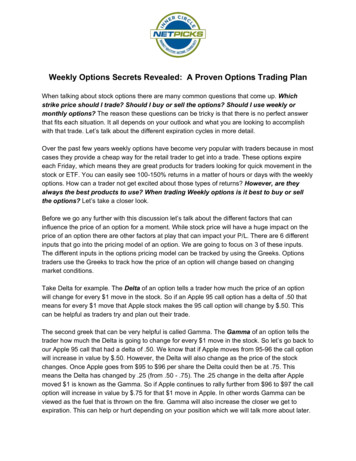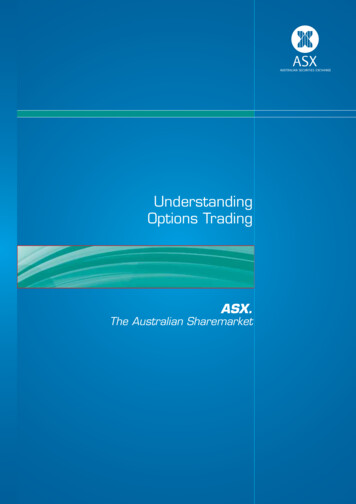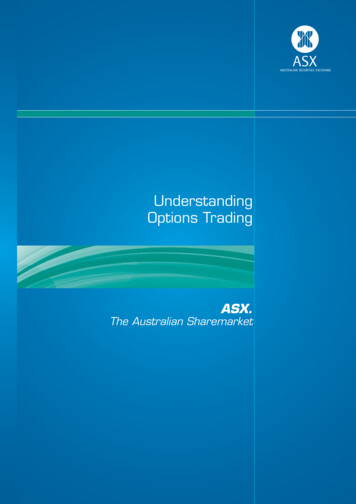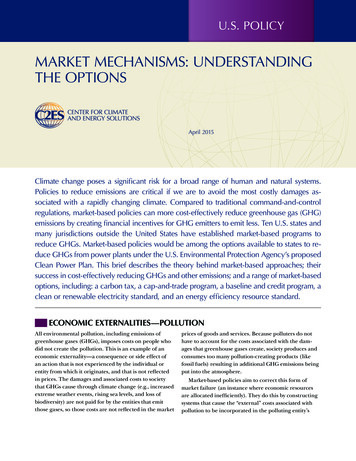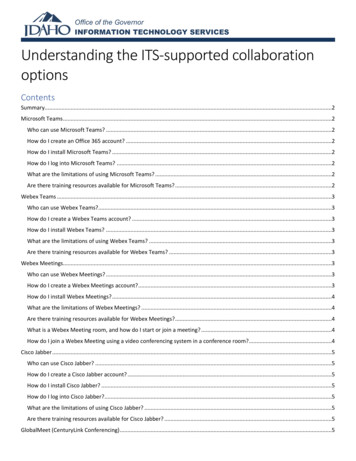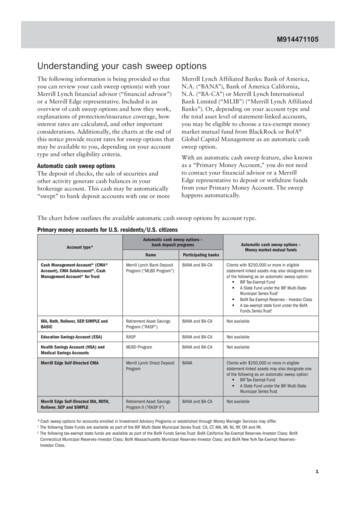
Transcription
UnderstandingOptions Trading
Disclaimer of LiabilityInformation provided is for educational purposes and does not constitute financial product advice. You should obtainindependent advice from an Australian financial services licensee before making any financial decisions. Although ASXLimited ABN 98 008 624 691 and its related bodies corporate (“ASX”) has made every effort to ensure the accuracy of theinformation as at the date of publication, ASX does not give any warranty or representation as to the accuracy, reliabilityor completeness of the information. To the extent permitted by law, ASX and its employees, officers and contractors shallnot be liable for any loss or damage arising in any way (including by way of negligence) from or in connection with anyinformation provided or omitted or from any one acting or refraining to act in reliance on this information.SPAN is a registered trademark of Chicago Mercantile Exchange Inc., used herein under license. Chicago MercantileExchange Inc. assumes no liability in connection with the use of SPAN by any person or entity.No part of this Booklet may be copied, reproduced, published, stored in a retrieval system or transmitted in any form orby any means in whole or in part without the prior written permission of the ASX Group.For these product/s the market is operated by ASX Limited ACN 008 624 691. Edition 19 printed September 2018 Copyright 2018 ASX Limited ABN 98 008 624 691. All rights reserved 2018Exchange Centre, 20 Bridge Street, Sydney NSW 2000 Telephone: 131 279asx.com.au
ContentsBefore you begin 4What is an option? 5Call options 5Put options 6Advantages of option trading 7Risk management 7Time to decide 7Speculation 7Leverage 7Diversification 7Income generation Option features The five components of an option contract 788Adjustments to option contracts 10Option pricing fundamentals 115. Index options let you trade all the stocksin an index with just one trade 216. Other strategies 21Trading index options 22How are index options different? 22Settlement method 22Some key advantages of trading index options 23Examples of how trading index options can work for you 23Pay-off diagrams 25Call option taker 25Call option writer 25Put option taker 26Put option writer 26Summary 27Risks of options trading 28Market risks 28Options are a wasting asset 28Effect of ‘leverage’ or ‘gearing’ 28Options writers face potentially unlimited losses 28Additional margin calls 28Liquidity risk 2813Liquidity and pricing relationships 28The option taker 13Orderly market powers 28The option writer 15Trading disputes 28Trading facilities 28Intrinsic value 11Time value 11Call options 11Put options 12The role of dividends in pricing and early exercise 12Parties to an option contract Tracking positions and costs How to track options via the internet andin the newspapers 1616Costs 16Margins 17How margins are calculated 17How margins are met 17Payment of margins 17You and your broker 1. Your relationship with your broker 29292. The paperwork: Client Agreement forms 293. Instructing a broker to trade options 304. Role of Market Makers 305. ASX Clear Pty Limited (ASX Clear) 31Options trading game 33Taxation 18Options online courses 34Tradeability 19Option prices 35How can options work for you? 20Glossary of terms 36Option contract specifications 381. Earn income 202. Protecting the value of your shares 203. Capitalising on share price movementswithout having to purchase shares 214. Using options gives you time to decide 21Notes 39Further information 403
Before you beginThe ASX options market has been operating since 1976. Since the market started, volumes haveincreased significantly. There are now over 70 different companies, Exchange Traded Funds (ETFs)and the S&P ASX 200 share price index to choose from. A list of companies over which ExchangeTraded Options (options) are traded can be found on the ASX website, asx.com.au/options.This booklet explains the concepts of options, how they workand what they can be used for. It should be noted that thisbooklet deals exclusively with Exchange Traded Options overlisted shares, ETFs and indices, and not company issued options.Information on other ASX products is available by calling 131 279or visiting asx.com.au. To assist in your understanding there is aglossary of terms on page 36.Option sellers are referred to as ‘writers’ because theyunderwrite (or willingly accept) the obligation to deliver oraccept the shares covered by an option. Similarly, buyers arereferred to as the ‘takers’ of an option as they take up the rightto buy or sell a parcel of shares.4Every option contract has both a taker (buyer) and a writer(seller). Options can provide protection for a share portfolio,additional income or trading profits. Both the purchase andsale of options, however, involve risk.Transactions should only be entered into by investors whounderstand the nature and extent of their rights, obligationsand risks.Understanding Options Trading
What is an option?An option is a contract between two parties giving the taker (buyer) the right, but not theobligation, to buy or sell a security at a predetermined price on or before a predetermined date.To acquire this right the taker pays a premium to the writer (seller) of the contract.For illustrative purposes, the term shares (or stock) is usedthroughout this booklet when referring to the underlyingsecurities. When considering options over an index, the sameconcepts generally apply. From time to time options may beavailable over other types of securities.Call optionsThe standard number of shares covered by one option contracton ASX is 100. However, this may change due to adjustmentevents such as a new issue or a reorganisation of capital in theunderlying share.Call option exampleAll of the examples in this booklet assume 100 shares percontract and ignore brokerage and ASX fees. You will needto consider these when evaluating an option transaction.For options over an index, the contract value is based on adollar value per point. Details can be checked in the contractspecifications.There are two types of options available: call options andput options.Call options give the taker the right, but not the obligation, tobuy the underlying shares at a predetermined price, on or beforea predetermined date.Santos Limited (STO) shares have a last sale price of 6.00.An available three month option would be an STO three month 6.00 call. A taker of this contract has the right, but not theobligation, to buy 100 STO shares for 6.00 per share at anytime until the expiry*. For this right, the taker pays a premium(or purchase price) to the writer of the option. In order to takeup this right to buy the STO shares at the specified price, thetaker must exercise the option on or before expiry.On the other hand, the writer of this call option is obliged todeliver 100 STO shares at 6.00 per share if the taker exercisesthe option. For accepting this obligation the writer receivesand keeps the option premium whether the option is exercisedor not.It is important to note that the takeris not obligated to exercise the option.Taker(Buyer)BrokerASXBrokerWriter(Seller)* The expiry day for stock options expiring up to and including June 2020 is usually the Thursday before the last Friday in the expiry month. For expiries beyond this date the expiry dayis usually the third Thursday of the month, unless ASX Clear determines another day. This may change for various reasons (e.g. for public holidays). There are also a limited number ofoptions that expire every week generally on a Thursday. Please check with your broker. For index options, refer to the contract specifications. Please check the ASX website or contact your broker.5
Put optionsPut options give the taker the right but not the obligation to sellthe underlying shares at a predetermined price on or before apredetermined date. The taker of a put is only required to deliverthe underlying shares if they exercise the option.Put option exampleAn available option would be an STO three month 6.00 put.This gives the taker the right, but not the obligation, to sell 100STO shares for 6.00 per share at any time until expiry. For thisright, the taker pays a premium (or purchase price) to the writerof the put option. In order to take up this right to sell the STOshares at a specified price the taker must exercise the option onor before expiry. The writer of the put option is obliged to buythe STO shares for 6.00 per share if the option is exercised. Aswith call options, the writer of a put option receives and keepsthe option premium whether the option is exercised or not.If the call or put option is exercised, the shares are traded atthe specified price. This price is called the exercise or strikeprice. The last date when an option can be exercised is calledexpiry day.There are two different exercise styles: American style, whichmeans the option can be exercised at any time prior to theexpiry; and European style, which means the option can only beexercised on the expiry day. Most stock options traded on ASXare American style.It is important to note that the takeris not obligated to exercise the option.Rights and obligationsCall OptionPut OptionTaker receives the rightto buy shares at the exerciseprice in return for payingthe premium toTakerWriter*the writer.(Buyer)(Seller)Writer receives andkeeps premium but nowhas the obligation to delivershares if the takerexercises.Taker receives the rightto sell shares at the exerciseprice in return for payingthe premium toWriterTaker*the writer.(Seller)(Buyer)Writer receives andkeeps premium but now hasthe obligation to buy theunderlying shares if thetaker exercises.* The taker of a put and writer of a call option do not have to own the underlying shares.6Understanding Options Trading
Advantages of option tradingRisk managementDiversificationPut options, when taken, allow you to hedge against a possiblefall in the value of shares you hold.Options can allow you to build a diversified portfolio for a lowerinitial outlay than purchasing shares directly.Time to decideIncome generationBy taking a call option, the purchase price for the shares islocked in. This gives the call option holder until the expiry day todecide whether or not to exercise the option and buy the shares.Likewise the taker of a put option has time to decide whether ornot to sell the shares.You can earn extra income over and above dividends by writingcall options against your shares, including shares bought usinga margin lending facility. By writing an option you receive theoption premium up front. While you get to keep the optionpremium, there is a possibility that you could be exercisedagainst and have to deliver your shares at the exercise price.SpeculationThe ease of trading in and out of an option position makes itpossible to trade options with no intention of ever exercisingthem. If you expect the market to rise, you may decide to buycall options. If you expect a fall, you may decide to buy putoptions. Either way you can sell the option prior to expiry totake a profit or limit a loss.It is important that you balance the advantages of tradingoptions with the risks before making any decisions. Detailsof the risks of options trading are set out on page 28.LeverageLeverage provides the potential to make a higher return froma smaller initial outlay than investing directly. However, leverageusually involves more risks than a direct investment in theunderlying shares. Trading in options can allow you to benefitfrom a change in the price of the share without having to paythe full price of the share. The following example helps illustratehow leverage can work for you.The table below compares the purchase of one call option and100 shares. The higher percentage return from the optiondemonstrates how leverage can work.OPTIONSTOCKBought on October 15 38 400Sold on December 15 67 450Profit 29 50Return on investment(not annualised)76.3%12.5%7
Option featuresThe ASX options market has been operating since 1976. Since the market started, volumes haveincreased significantly. There are now over 70 different companies, ETFs and the S&P ASX 200share price index to choose from. A list of companies over which Exchange Traded Options (options)are traded can be found on the ASX website, asx.com.au/options.The ease of trading in and out of options on ASX’s optionsmarket is assisted by the standardisation of the followingoption contract components:The five components of an option contract1. Underlying securitiesOptions traded on ASX’s options market are only available forcertain securities and the S&P ASX 200 share price index. Thesesecurities are referred to as underlying securities or underlyingshares. They must be listed on ASX and are selected by ASXClear according to specific guidelines. The issuers of underlyingsecurities do not participate in the selection of securities againstwhich options may be listed.2. Contract size3. Expiry day4. Exercise pricesThere is a fifth component, the option premium, which is notstandardised but rather determined by market forces. ASXoperates the options market, while ASX Clear Pty Limited (ASXClear) operates the clearing facility for ASX’s options market.Among ASX’s responsibilities is the setting of the standardisedoption components.One option contract usually represents100 underlying shares.1. Underlying securities/approved indicesCalls and puts over the same underlying security are termedclasses of options. For example, all call and put options listedover Lend Lease Corporation (LLC) shares, regardless of exerciseprice and expiry day, form one class of option. A list of all theclasses of options trading on ASX’s options market can be foundon the ASX website asx.com.au/options.2. Contract sizeOn ASX’s options market an option contract size is standardisedat 100 underlying shares. That means, one option contractrepresents 100 underlying shares. This may change if t
The ease of trading in and out of an option position makes it possible to trade options with no intention of ever exercising them. If you expect the market to rise, you may decide to buy call options. If you expect a fall, you may decide to buy put options. Either way you can sell the option prior to expiry to take a profit or limit a loss. Leverage Leverage provides the potential to make a .
